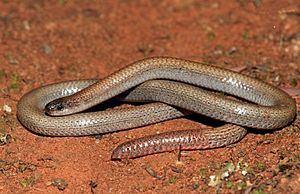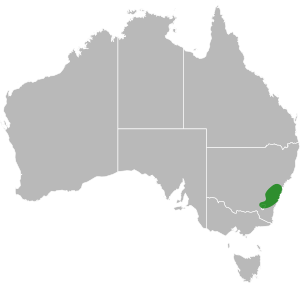Pink-tailed worm-lizard facts for kids
Quick facts for kids Pink-tailed worm-lizard |
|
|---|---|
 |
|
| Conservation status | |
| Scientific classification | |
 |
The pink-tailed worm-lizard (also known as the granite worm-lizard) is a unique legless lizard found in Australia. Its scientific name is Aprasia parapulchella. This rare animal looks a bit like a small snake mixed with a worm.
These lizards can grow up to 14 centimeters long. They have a distinct pink tail and a white belly. Their head and neck are brown, while the rest of their upper body is pale grey. Each scale on their back has a dark bar, making them look like they have tiny dots down their back.
You can find these lizards in specific areas of Australia. They live on two hills near Tarcutta, in Bathurst, New South Wales, and near Bendigo in Victoria. They also live along the Molonglo River and Murrumbidgee River, and on Mount Taylor in the Australian Capital Territory.
Pink-tailed worm-lizards mostly eat small creatures without backbones, called invertebrates. They find their food under rocks. Their favorite meal is ant eggs, especially from Iridomyrmex ants and Rhytidoponera metallica ants. They often hide under rocks that are between 0.15 and 0.6 meters in size.
Understanding the Pink-tailed Worm-Lizard's Body
The pink-tailed worm-lizard has a rounded head and tail. It might look like a snake, but there are key differences. Unlike snakes, it has small, scaly flaps where its back legs would be. Its tongue is also flat and long, not forked like a snake's. You won't see any ears on this lizard either.
Some special features that help identify this species include no patterns on the side of its head. It also has two scales in front of its eyes and three scales near its rear. The first upper lip scale and the nose scale are joined together.
These lizards can weigh from 0.1 to 4.0 grams. When they are one year old, they are about 6 centimeters long from snout to vent (the opening at the end of the body). By their second year, they reach about 8 centimeters, and by their third year, 9.6 centimeters. Adult males, usually over three years old, average 10.9 centimeters. Females are a bit larger, averaging about 12 centimeters.
Why the Pink-tailed Worm-Lizard is in Danger
The pink-tailed worm-lizard faces several threats that make it a rare species. Its home is being broken up into smaller pieces, which is called habitat fragmentation. This makes it harder for them to find food and mates.
Other dangers include people removing rocks from their habitat. This takes away their homes and hiding spots. Grazing by livestock, planting too many trees, and the spread of weeds also harm their living areas. Even ploughing land can destroy their underground homes.
Images for kids






